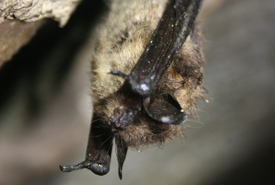
Little brown bat (Photo by Ann Froschauer, USFWS/Wikimedia Commons)
Little brown bat
What does it look like?
Little brown bat is one of 19 bat species in Canada. It has glossy brown fur and measures just eight to 10 centimetres in length. It weighs just seven to nine grams, and has a wingspan from 25 to 27 centimetres. This species most closely resembles the northern long-eared bat. It can be distinguished by its shorter ears and the fleshy projection covering the ear’s entrance, which is shorter and rounded at the tip in the little brown bat. Northern long-eared bats have a more restricted distribution, and are absent from western BC, southern Alberta and Saskatchewan.
Where does it live?
Of all bat species in Canada, little brown bat has the widest distribution. It is found in every province and territory except Nunavut. This species is also found throughout most of the United States and the cooler mountainous regions of central Mexico.
Like most bat species, little brown bats are nocturnal, typically roosting in buildings, trees and caves during the day, with cave roosting occurring with pre- and post-hibernation. Throughout summer, females raise offspring in attics, abandoned buildings, barns and tree cavities. In late summer and fall, bats migrate from their summer roosts to caves and mines, where they hibernate from October or November to March or April; males tend to emerge later than females, as late as early June. Bats fly to caves and abandoned mines for hibernation, as their humid environment with above-freezing temperatures are preferred locations.
What is unique about this species?
Like most other North American bats, little brown bat uses echolocation to find its insect prey. They do this by emitting sound at a high frequency and listening to the returning sound waves to determine the size and location of objects. Little brown bats can eat half of their body weight in insects every night and nursing mothers sometimes eat more than their body weight. Mothers give birth to one pup in June or July, the pup stays behind in the cavity while its mother forages. Pups learn to fly at three weeks old.
What is this species’ conservation status?
Little brown bats are endangered in Canada, where 50 per cent of the species’ global range is located. This status is mainly due to an invasive fungus that causes white-nose syndrome. This fungus thrives in cool, moist environments and infects the exposed skin of the muzzle and wings of hibernating bats. It causes bats to use more energy than they can afford during hibernation and to wake up more frequently than healthy bats, usually leading to death.
Other threats to this species include habitat loss and degradation, pollution, climate change, pesticides and harm from wind turbines.
What is NCC doing to protect habitat for this species?
Little brown bat occurs in several natural areas where NCC properties are located. It can be found in the Rocky Mountain Trench and West Kootenay in BC; Cooking Lake Moraine in Alberta; Happy Valley Forest, Frontenac Arch, Minesing Wetlands and Southern Norfolk Sand Plains in Ontario; the West Boreal Transition, Lower Qu’Appelle – Assiniboine – Quill Lakes and Milk River Basin in Saskatchewan; the Interlake and Riding Mountain in Manitoba; and the Green Mountains in Quebec. By protecting these areas, NCC is helping to create viable habitat where bats can hibernate, forage and raise their young.
NCC is also working with the Toronto Zoo on their Native Bat Conservation Program, which involves monitoring bats in Ontario to learn more about their populations.
In Saskatchewan, NCC has conducted acoustic surveys on 18 different properties to build an inventory of the bat species present. From 2018 to 2022, NCC conducted a project to capture bats, affix radio transmitters and track them to their roost site; this will help determine habitat use and roost site selection by bats in the mixed-wood forest of central Saskatchewan and inform NCC’s management of the properties.
In BC, NCC has conducted bat detection surveys, participated in NA Bat (a North American grid-based survey), put up several types of bat boxes in the Frog Bear Conservation Corridor and is working with researchers at the Wildlife Conservation Society to determine how to prioritize securement and how to properly steward the property for threats to bats, such as the emergence of white-nose syndrome.
In 2019, NCC plans to locate populations and hibernacula (winter hibernation sites) of little brown bat on NCC properties in Quebec’s Green Mountains. In the Green Mountains, local conservation groups, including Granby Zoo and Appalachian Corridor, are working together to locate bats and promote their protection to the public. NCC has made several land acquisitions that contribute to their maintenance.
NCC’s Alberta Region team started working with provincial species at risk biologists in the grasslands where evidence of an overwintering site may occur. We hope to learn more about the bats’ use of our to better understand how we can manage our properties and infrastructure to their benefit.





